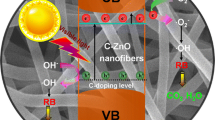Abstract
Polyacrylonitrile/zinc oxide (PAN/ZnO) composite nanofiber membranes with different ZnO morphologies were fabricated by repeatedly alternating hot–cold immersion and single alternating hot–cold immersion methods. The influence of the PAN/ZnCl2 ratio and different immersion methods on the morphology, microstructure, and properties of the nanofiber membranes was investigated by using field-emission scanning electron microscopy (FE-SEM), Fourier-transform infrared spectroscopy (FT-IR), X-ray diffraction (XRD) analysis, thermogravimetric analysis (TGA), and ultraviolet–visible (UV–Vis) spectroscopy. A possible mechanism for different morphologies of PAN/ZnO nanofiber membranes with different PAN/ZnCl2 ratio through different immersion processes was presented, and well-dispersed ZnO nanorod clusters with smallest average dimeter of 115 nm and hexagonal wurtzite structure were successfully anchored onto the PAN nanofiber surface for R-7/1 nanofiber membrane. Compared to S-5/1 prepared by single alternating hot–cold immersion method, the PAN/ZnO nanofiber membrane fabricated by repeatedly alternating hot–cold immersion method (especially for R-7/1) showed improved thermal stability and high photocatalytic activity for methylene blue (MB). Compared to S-5/1, decomposition temperature at 5% weight loss (T 5%) was increased by 43 °C from 282 to 325 °C for R-7/1; meanwhile, R-7/1 showed higher photocatalytic degradation ratio of approximately 100% (after UV light irradiation for 8 h) than 65% for S-5/1 even after irradiation for 14 h. Moreover, the degradation efficiency of R-7/1 with good reuse stability remained above 94% after 3 cycles.

A facile route was presented to fabricate uniform zinc oxide nanorod clusters on polyacrylonitrile nanofiber membranes with superior thermal stability and photocatalytic activity for methylene blue (excellent recyclability).





Similar content being viewed by others
References
Arshad SN et al (2011) Strong carbon nanofibers from electrospun polyacrylonitrile. Carbon 49(5):1710–1719
Bashir A et al (2009) High-performance zinc oxide transistors and circuits fabricated by spray pyrolysis in ambient atmosphere. Adv Mater 21(21):2226–2231
Bouzourâa MB et al (2016) Effects of silicon porosity on physical properties of ZnO films. Mater Chem Phys 175:233–240
Chen Z et al (2013) Synthesis of graphene-ZnO nanorod nanocomposites with improved photoactivity and anti-photocorrosion. CrystEngComm 15(15):3022–3030
Djurišić AB et al (2010) ZnO nanostructures for optoelectronics: material properties and device applications. Prog Quant Electron 34(4):191–259
Eichhorn SJ et al (2010) Review: current international research into cellulose nanofibres and nanocomposites. J Mater Sci 45(1):1–33
Hassan JJ et al (2011) High-quality vertically aligned ZnO nanorods synthesized by microwave-assisted CBD with ZnO–PVA complex seed layer on Si substrates. J Alloys Compd 509(23):6711–6719
Law M et al (2005) Nanowire dye-sensitized solar cells. Nature Mater 4(6):455–459
Lee JM et al (2009) ZnO nanorod-graphene hybrid architectures for multifunctional conductors. J Phys Chem C 113(44):19134–19138
Li MC et al (2015) Cellulose nanoparticles: structure-morphology-rheology relationships. ACS Sustain Chem Eng 3(5):821–832
Liu Y et al (2014) A novel approach for the preparation of nanocrystalline cellulose by using phosphotungstic acid. Carbohyd Polym 110:415–422
Neghlani PK et al (2011) Preparation of aminated-polyacrylonitrile nanofiber membranes for the adsorption of metal ions: comparison with microfibers. J Hazard Mater 186(1):182–189
Olaru N et al (2014) Zinc oxide nanocrystals grown on cellulose acetate butyrate nanofiber mats and their potential photocatalytic activity for dye degradation. Ind Eng Chem Res 53(46):17968–17975
Olson DC et al (2006) Hybrid photovoltaic devices of polymer and ZnO nanofiber composite. Thin Solid Films 496(1):26–29
Pradhan B et al (2007) Vertically aligned ZnO nanowire arrays in Rose Bengal-based dye-sensitized solar cells. Sol Energy Mater Sol Cells 91(9):769–773
Shao D et al (2011) Depositon of ZnO on polyacrylonitrile fiber by thermal solvent coating. Fiber Polym 12(2):214–219
Shinagawa T et al (2014) Solution-processed high-haze ZnO pyramidal textures directly grown on a TCO substrate and the light-trapping effect in Cu2O solar cells. J Mater Chem C 2(16):2908–2917
Wahab R et al (2011) Photocatalytic activity of zinc oxide micro-flowers synthesized via solution method. Chem Eng J 168(1):359–366
Yang RT et al (2016) Flower-like zinc oxide nanorod clusters grown on spherical cellulose nanocrystals via simple chemical precipitation method. Cellulose 23(3):1871–1884
Yu HY et al (2013) Comparison of the reinforcing effects for cellulose nanocrystals obtained by sulfuric and hydrochloric acid hydrolysis on the mechanical and thermal properties of bacterial polyester. Compos Sci Technol 87:22–28
Yu HY et al (2015a) A facile one-pot route for preparing cellulose nanocrystal/zinc oxide nanohybrids with high antibacterial and photocatalytic activity. Cellulose 22(1):261–273
Yu HY et al (2015b) Silylation of cellulose nanocrystals and their reinforcement of commercial silicone rubber. J Nanopart Res 17(9):1–13
Yu HY et al (2014) One-pot green fabrication and antibacterial activity of thermally stable corn-like CNC/Ag nanocomposites. J Nanopart Res 16(1):1–12
Zhou J et al (2008) Flexible piezotronic strain sensor. Nano Lett 8(9):3035–3040
Acknowledgements
We would like to thank the “521” Talent Project of Zhejiang Sci-Tech University.
Author information
Authors and Affiliations
Corresponding authors
Ethics declarations
Conflict of interest
The authors declare that they have no conflict of interest.
Funding
The present study was supported by the National Natural Science Foundation of China (51403187); the public technology research plan of Zhejiang Province, China under Grant No. 2015C33111; and open fund in Top Priority Discipline of Zhejiang Province in Zhejiang Sci-Tech University (2015YXQN04, 2016YXQN07, 2015YXQN11).
Rights and permissions
About this article
Cite this article
Zhou, Y., Li, X., Yu, HY. et al. Facile fabrication of controllable zinc oxide nanorod clusters on polyacrylonitrile nanofibers via repeatedly alternating immersion method. J Nanopart Res 18, 359 (2016). https://doi.org/10.1007/s11051-016-3678-5
Received:
Accepted:
Published:
DOI: https://doi.org/10.1007/s11051-016-3678-5



